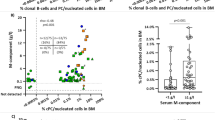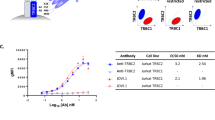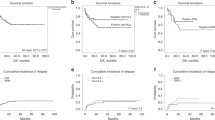Abstract
Transplantation of HLA-mismatched stem cells may allow determination of chimerism status of single cells by differential expression of HLA molecules. Monoclonal antibodies against HLA antigens can be used to determine the HLA type of sub-populations by standard flow cytometry. Blood samples from 23 patients transplanted from HLA-mismatched family donors were monitored using HLA-specific antibodies. Suitable antibodies could be found for all donor recipient pairs by using differences in HLA Bw4 and Bw6 groups or other serological antigens. Pretransplant controls of donor and recipient were used to correct for variable fluorescence intensities of the antibodies and sub-populations. Owing to the high sensitivity, cell populations with a minimum frequency of 0.1% were detectable. Flow-cytometric analysis was confirmed by chimerism analysis of immunomagnetically isolated T cells by standard PCR technique. In addition to chimerism evaluation, HLA antibodies improved the detection of leukemic cells after transplantation with aberrant phenotype. In conclusion, flow cytometry using antibodies against HLA antigens is an interesting tool for determination of chimerism and minimal residual disease after HLA-mismatched transplantation. Information about the chimerism status is given on a single-cell level and allows fast and convenient analysis of sub-populations.
This is a preview of subscription content, access via your institution
Access options
Subscribe to this journal
Receive 12 print issues and online access
$259.00 per year
only $21.58 per issue
Buy this article
- Purchase on Springer Link
- Instant access to full article PDF
Prices may be subject to local taxes which are calculated during checkout





Similar content being viewed by others
References
Lang P, Schumm M, Greil J, Bader P, Klingebiel T, Muller I et al. A comparison between three graft manipulation methods for haploidentical stem cell transplantation in pediatric patients: preliminary results of a pilot study. Klin Padiatr 2005; 217: 334–338.
Handgretinger R, Klingebiel T, Lang P, Schumm M, Neu S, Geiselhart A et al. Megadose transplantation of purified peripheral blood CD34(+) progenitor cells from HLA-mismatched parental donors in children. Bone Marrow Transplant 2001; 27: 777–783.
Lang P, Greil J, Bader P, Handgretinger R, Klingebiel T, Schumm M et al. Long-term outcome after haploidentical stem cell transplantation in children. Blood Cells Mol Dis 2004; 33: 281–287.
Kurtzberg J, Graham M, Casey J, Olson J, Stevens CE, Rubinstein P . The use of umbilical cord blood in mismatched related and unrelated hemopoietic stem cell transplantation. Blood Cells 1994; 20: 275–283.
Lambertengh DG, Soligo D, Della VA, Bertolini F, Poli F, Romitti L et al. Unrelated mismatched cord blood transplantation in an adult with secondary AML. Bone Marrow Transplant 1996; 18: 469–472.
Jaing TH, Hung IJ, Yang CP, Chen SH, Sun CF, Chow R . Rapid and complete donor chimerism after unrelated mismatched cord blood transplantation in 5 children with beta-thalassemia major. Biol Blood Marrow Transplant 2005; 11: 349–353.
Quesenberry PJ, Zhong S, Wang H, Stewart M . Allogeneic chimerism with low-dose irradiation, antigen presensitization, and costimulator blockade in H-2 mismatched mice. Blood 2001; 97: 557–564.
Truitt RL, Atasoylu AA . Impact of pretransplant conditioning and donor T cells on chimerism, graft-versus-host disease, graft-versus-leukemia reactivity, and tolerance after bone marrow transplantation. Blood 1991; 77: 2515–2523.
Ceredig R, Schreyer M . Immunohistochemical localization of host and donor-derived cells in the regenerating thymus of radiation bone marrow chimeras. Thymus 1984; 6: 15–26.
Bachar-Lustig E, Li HW, Gur H, Krauthgamer R, Marcus H, Reisner Y . Induction of donor-type chimerism and transplantation tolerance across major histocompatibility barriers in sublethally irradiated mice by Sca-1(+)Lin(−) bone marrow progenitor cells: synergism with non-alloreactive (host × donor)F(1) T cells. Blood 1999; 94: 3212–3221.
Fuehrer M, Gerusel-Bleck M, Konstantopoulos N, der-Goetze C, Walther JU . FISH analysis of native smears from bone marrow and blood for the monitoring of chimerism and clonal markers after stem cell transplantation in children. Int J Mol Med 2005; 15: 291–297.
Turkiewicz D, Gorczynska E, Toporski J, Kalwak K, Rybka B, Noworolska D et al. Monitoring of hematopoietic chimerism after sex-mismatched allogeneic stem cell transplantation (alloSCT) by dual-color FISH analysis of X and Y chromosomes. Leuk Res 2003; 27: 993–998.
Lapointe C, Forest L, Lussier P, Busque L, Lagace F, Perreault C et al. Sequential analysis of early hematopoietic reconstitution following allogeneic bone marrow transplantation with fluorescence in situ hybridization (FISH). Bone Marrow Transplant 1996; 17: 1143–1148.
Palka G, Stuppia L, Di BP, Morizio E, Peila R, Franchi PG et al. FISH detection of mixed chimerism in 33 patients submitted to bone marrow transplantation. Bone Marrow Transplant 1996; 17: 231–236.
Zeng F, Chen M, Katsumata M, Huang W, Gong Z, Hu W et al. Identification and characterization of engrafted human cells in human/goat xenogeneic transplantation chimerism. DNA Cell Biol 2005; 24: 403–409.
Fehse B, Chukhlovin A, Kuhlcke K, Marinetz O, Vorwig O, Renges H et al. Real-time quantitative Y chromosome-specific PCR (QYCS-PCR) for monitoring hematopoietic chimerism after sex-mismatched allogeneic stem cell transplantation. J Hematother Stem Cell Res 2001; 10: 419–425.
Bader P, Holle W, Klingebiel T, Handgretinger R, Niethammer D, Beck J . Quantitative assessment of mixed hematopoietic chimerism by polymerase chain reaction after allogeneic BMT. Anticancer Res 1996; 16: 1759–1763.
Kreyenberg H, Holle W, Mohrle S, Niethammer D, Bader P . Quantitative analysis of chimerism after allogeneic stem cell transplantation by PCR amplification of microsatellite markers and capillary electrophoresis with fluorescence detection: the Tuebingen experience. Leukemia 2003; 17: 237–240.
Bader P, Niemeyer C, Willasch A, Kreyenberg H, Strahm B, Kremens B et al. Children with myelodysplastic syndrome (MDS) and increasing mixed chimaerism after allogeneic stem cell transplantation have a poor outcome which can be improved by pre-emptive immunotherapy. Br J Haematol 2005; 128: 649–658.
Cotteret S, Belloc F, Boiron JM, Bilhou-Nabera C, Dumain P, Boyer C et al. Fluorescent in situ hybridization on flow-sorted cells as a tool for evaluating minimal residual disease or chimerism after allogenic bone marrow transplantation. Cytometry 1998; 34: 216–222.
Matthes-Martin S, Lion T, Haas OA, Frommlet F, Daxberger H, Konig M et al. Lineage-specific chimaerism after stem cell transplantation in children following reduced intensity conditioning: potential predictive value of NK cell chimaerism for late graft rejection. Leukemia 2003; 17: 1934–1942.
Kogler G, Wolf HH, Heyll A, Arkesteijn G, Wernet P . Detection of mixed chimerism and leukemic relapse after allogeneic bone marrow transplantation in subpopulations of leucocytes by fluorescent in situ hybridization in combination with the simultaneous immunophenotypic analysis of interphase cells. Bone Marrow Transplant 1995; 15: 41–48.
Gerritsen WR, Jagiello CA, Bourhis JH . Detection of chimerism in subpopulations of cells by fluorescence in situ hybridization and immunofluorescent staining of cell surface antigens. Bone Marrow Transplant 1994; 13: 441–447.
Handgretinger R, Schumm M, Lang P, Greil J, Reiter A, Bader P et al. Transplantation of megadoses of purified haploidentical stem cells. Ann N Y Acad Sci 1999; 872: 351–361.
Schwinger W, Urban C, Lackner H, Kerbl R, Benesch M, Dornbusch HJ et al. Unrelated peripheral blood stem cell transplantation with ‘megadoses’ of purified CD34+ cells in three children with refractory severe aplastic anemia. Bone Marrow Transplant 2000; 25: 513–517.
Reisner Y, Martelli MF . Tolerance induction by ‘megadose’ transplants of CD34+ stem cells: a new option for leukemia patients without an HLA-matched donor. Curr Opin Immunol 2000; 12: 536–541.
Bethge WA, Haegele M, Faul C, Lang P, Schumm M, Bornhauser M et al. Haploidentical allogeneic hematopoietic cell transplantation in adults with reduced-intensity conditioning and CD3/CD19 depletion: fast engraftment and low toxicity. Exp Hematol 2006; 34: 1746–1752.
Bader P, Hancock J, Kreyenberg H, Goulden NJ, Niethammer D, Oakhill A et al. Minimal residual disease (MRD) status prior to allogeneic stem cell transplantation is a powerful predictor for post-transplant outcome in children with ALL. Leukemia 2002; 16: 1668–1672.
Campana D, Coustan-Smith E . Detection of minimal residual disease in acute leukemia by flow cytometry. Cytometry 1999; 38: 139–152.
Kerst G, Kreyenberg H, Roth C, Well C, Dietz K, Coustan-Smith E et al. Concurrent detection of minimal residual disease (MRD) in childhood acute lymphoblastic leukaemia by flow cytometry and real-time PCR. Br J Haematol 2005; 128: 774–782.
Acknowledgements
We thank Olga Bartuli, Christiane Braun, Gabriele Hochwelker, Ulrike Junker, Stephanie Katz, Susanne Schneider and Anja Wolf for excellent technical assistance.
Author information
Authors and Affiliations
Corresponding author
Rights and permissions
About this article
Cite this article
Schumm, M., Feuchtinger, T., Pfeiffer, M. et al. Flow cytometry with anti HLA-antibodies: a simple but highly sensitive method for monitoring chimerism and minimal residual disease after HLA-mismatched stem cell transplantation. Bone Marrow Transplant 39, 767–773 (2007). https://doi.org/10.1038/sj.bmt.1705676
Received:
Revised:
Accepted:
Published:
Issue Date:
DOI: https://doi.org/10.1038/sj.bmt.1705676
Keywords
This article is cited by
-
A novel flow-cytometric based method to assess post-HSCT donor chimerism exploiting RNA hybridization
Bone Marrow Transplantation (2024)
-
Refinement of treatment strategies in ex vivo T-cell-depleted haploidentical SCT for pediatric patients
Bone Marrow Transplantation (2015)
-
Dendritic cell reconstitution is associated with relapse-free survival and acute GVHD severity in children after allogeneic stem cell transplantation
Bone Marrow Transplantation (2015)
-
Follow-up of the patients after bone marrow transplantation for red blood cell chimerism using flow cytometry
Comparative Clinical Pathology (2014)
-
New strategies for haploidentical transplantation
Pediatric Research (2012)



